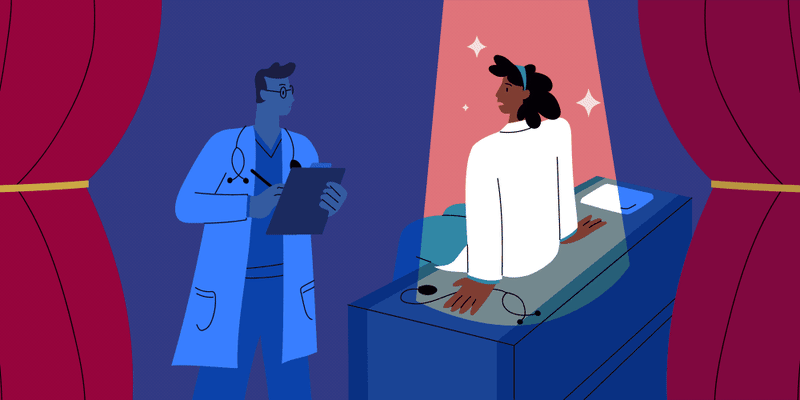
Aside from passive word of mouth and referrals, most practices rely on proactive lead generation to build their patient base. Let’s assume everyone promotes their practice through social media or more traditional advertising. How would a doctor stand out among the competition such that a patient finds one practice over another? Maybe it’s not so much how the patient finds the doctor, but rather how the doctor “finds” the patient.
Strong vs Weak Call-to-Action Button
To capture leads through a physician website, a doctor will place a call-to-action button on their site. This refers to the clickable “button” that offers some good or service to the visitor in exchange for their contact info. This can include the opportunity to sign up for a newsletter/e-book, an offer to schedule a consultation or the ability to chat online.
As explained here, the call-to-action buttons mentioned above are best in capturing consumers that are further down the sales funnel and ready to commit to either a consult or procedure. Not everyone is that far along in the process.
Beat your competition in the race to capture potential patients
So the trick is to capture everyone, no matter how far along they are in the process. Better yet, the goal should be to capture leads so early in the process that the physician’s practice captures the potential patient earlier than the competitors. In other words, “find” the patient that’s already on your website and get them into your sales funnel before the competition does.
To do this requires a call-to-action that is so tantalizing to the patient, that they’re willing to provide their contact info in exchange for information the doctor has. The opportunity to get the doctor’s latest e-book, suffice it to say, is not adequately tantalizing! Neither is signing up for their newsletter. The information has to be otherwise elusive to the patient. At the same time, the effort to accept that call to action must be sufficiently low, so that as many consumers as possible take that action.
More succinctly, an effective call-to-action must 1) allow the consumer to obtain difficult to find information, 2) incentivize the consumer to provide their contact info and 3) requires very little motivation on the part of the patient. This results in a sales funnel that runneth over!
Get A Quote Now!
What’s the call-to-action that meets these three parameters? “Get A Quote Now!” Everyone, regardless of where they are in the sales funnel, wants to know the cost of a procedure. After the patient clicks on the Get A Quote Now button, they’re redirected to a Price Estimator within the doctor’s website. There, they can choose procedures of interest and submit their “wish list” along with their contact info to receive instant, automated pricing information specifically for that doctor.
Pricing is so elusive, especially pricing specific for a particular doctor. This satisfies the first parameter of a great call-to-action button. Because it’s so elusive, the patient is willing to provide their contact info to get it. This satisfies the second parameter. And with just a few clicks, and the ability to avoid calling the office to determine the cost, this automated process satisfies the third parameter.
Moreover, if these three parameters are met, this will allow the physician to bring leads into the sales funnel far earlier than previously possible. While these consumers in their research phase may have already been visitors to the doctor’s website, they had no reason to leave behind their contact info before. Why? Because they weren’t ready to schedule a consult or take any other action made available to them on the website.
With a “Get a Quote Now” call-to-action, the doctor’s site will now capture these previously unengaged visitors. In other words, they were already on the doctor’s site, the doctor just didn’t know it. With a more effective call-to-action button, the doctor is finding these consumers earlier in the process and effectively sidelining the competition.
Patience is a Virtue
Just because the website is generating a ton of leads, the doctor’s office can’t expect every one of these price-aware consumers to convert into patients. Since the site is now capturing leads earlier in the process, more of these consumer leads are in the research phase. They may not be ready to come in. But by having their contact information, the office should follow up with every lead, establish rapport, explain what differentiates the doctor from others and nurture that relationship. And by re-engaging with all of those leads via a monthly email newsletter, eventually, many of them will come in.
In this study published in a peer-reviewed journal, 17.8% of consumers that submitted wishlists through a Price Estimator on the author’s website over the course of a year came in for a consultation. 62.2% of those consultations converted into procedures. When compared to non-price-aware patients, the study found that price-aware patients are 41% more likely to book a procedure than non-price aware patients.
Based on data from a leading price transparency platform, consumers return to the Price Estimator on a doctor’s site and submit multiple wishlists 41.4 days apart. This confirms what we already knew: consumers take time to consider a procedure. But the difference is now the doctor’s office knows every time the visitor returns to the site because they submit a wishlist 1) to see if pricing has changed or because 2) they want to check pricing for a different combination of procedures. Whatever the reason, the doctor’s office is aware they’re “back” and this gives the office another opportunity to follow up and answer any questions and further nurture that relationship.
Price Transparency + Lead Generation
This is simply the combination of price transparency and lead generation. To be sure, price transparency does not mean the doctor is competing on price. It’s simply another data point that goes into the education of the patient. And just because a patient wants to know the cost of a procedure doesn’t make them a price shopper. So break with the old school thoughts regarding price. If utilized appropriately, it can be the greatest lead generation technique to capture patients before your competition does.
Jonathan Kaplan, MD is a board-certified plastic surgeon based in San Francisco, CA and founder/CEO of BuildMyBod Health.







